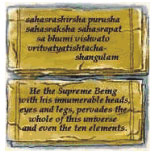|
HinduOfUniverse
Vedas - Upanishads - Puranas
Vedas

The oldest literature of Indian thought is the Veda, a collection of
religious and philisophical poems and hymns composed over several
generations beginning as early as 3000 BC. The Veda was composed in
Sanskrit, the intellectual language of both ancient and classical Indian
civilizations. Four collections were made, so it is said that there are
four Vedas. The four as a group came to be viewed as sacred in Hinduism.
Some Vedic hymns and poems address philosophic themes, such as the
henotheism that is key to much Hindu theology. Henotheism is the idea
that one God takes many different forms, and that although individuals
may worship several different gods and goddesses, they really revere but
one Supreme Being.
There are four Vedas:
The Rig-Veda
Its traditional date goes back to 3000 BC, something which the German
scholar Max Mueller accepted. As a body of writing, the Rig-Veda (the
wisdom of verses) is nothing short of remarkable. It contains 1028 hymns
(10,589 verses which are divided into ten mandalas or book-sections)
dedicated to thirty-three different gods. The most often addressed gods
were nature gods like Indra (rain god; king of heavens), Agni (fire
god), Rudra (storm god; the 'howler'), Soma (the draught of immortality,
an alcoholic brew).
The Sama-Veda
The Sama-Veda or the wisdom of chants is basically a collection of
samans or chants, derived from the eighth and ninth books of the
Rig-Veda. These were meant for the priests who officiated at the rituals
of the soma ceremonies. There are painstaking instructions in Sama-Veda
about how particular hymns must be sung; to put great emphasis upon
sounds of the words of the mantras and the effect they could have on the
environment and the person who pronounced them.
The Yajur-Veda
The Yajur-Veda or the wisdom of sacrifices lays down various sacred
invocations (yajurs) which were chanted by a particular sect of priests
called adhvaryu. They performed the sacrificial rites. The Veda also
outlines various chants which should be sung to pray and pay respects to
the various instruments which are involved in the sacrifice.
The Atharva-Veda
The Atharva-Veda (the wisdom of the Atharvans) is called so because the
families of the atharvan sect of the Brahmins have traditionally been
credited with the composition of the Vedas. It is a compilation of hymns
but lacks the awesome grandeur which makes the Rig-Veda such a
breathtaking spiritual experience.
Upanishads

The term Upanishad means sitting down near; this implies the students
sitting down near their Guru to learn the big secret. In the splendid
isolation of their forest abodes, the philosophers who composed the
Upanishads contemplated upon the various mysteries of life and its
creation – whether common, or metaphysical. The answers were however not
open to all, but only for select students. The reason for this was
simple: not everyone can handle knowledge.
The composition of the Upanishads marks a significant and stride
forward in the direction of knowing the mystery of earth's creation and
one comes tantalizingly close to the answers. Through episodes,
commentaries, stories, traditions and dialogue, the Upanishads unfold
the fascinating tale of creation, life, the essence of life and of that
beyond to the seeker of truth.
There is no exact date for the composition of the Upanishads. They
continued to be composed over a long period, the core being over 7th
-5th centuries BC. The Upanishads were originally called Vedanta, which
literally means the conclusion to the Vedas.
In the Upanishads, views about Brahman (the Absolute, or God) and
atman (one's true self) were proposed.
There are 18 principal Upanishads viz:
Brhad-aranyaka Upanishad
The Brhad-aranyaka Upanishad is widely accepted to be the most important
of all Upanishads. It has three khandas or parts. The madhu khanda
contemplates on the relationship between the individual and the
Universal self. The muni khanda or yajnavalkya is a debate which goes on
to give the philosophical backing to the earlier teaching. The khila
khanda tackles various rituals of worship and
meditation.
Chandogya Upanishad
This Upanishad is a part of the Sama-Veda (see The Vedas). The name
comes from the singer of the songs (samans) who is called Chandoga. The
initial chapters of the Upanishad, discuss the ritual of sacrifice. The
others debate the origin and profundity of the concept of Om, among
other things.
Aitareya Upanishad
This one forms part of the Rig-Veda. The purpose is to make the reader
understand the deeper meaning of sacrifice and to take him away from the
outer trappings of the actual act.
Taittriya Upanishad
A part of the Yajur-Veda, this Upanishad is divided into three sections
or vallis. The siksa valli deals with the phonetics of the chants, while
the others, brahmananda valli and bhrgu valli deal with
self-realization.
Isa Upanishad
Also called the Isavasya Upanishad, this book deals with the union of
God, the world, being and becoming. The stress is on the Absolute in
relation with the world (paramesvara). The gist of the teachings is that
a person's worldly and otherworldly goals need not necessarily be
opposed to each other.
Kena Upanishad
The name of this Upanishad comes from the first word kena, or by whom.
It has two sections of prose and two of poetry. The verses deal with the
supreme spirit or the absolute principle (brahmaana) and the prose talks
of ishvara (god). The moral of the story is that the knowledge of
ishvara reveals the way to self-realization.
Katha Upanishad
Also called the Kathakopanishad, this Upanishad uses a story (katha)
involving a young Brahmin boy called Nachiketa to reveal the truths of
this world and the other beyond the veil.
Prashna Upanishad
Prashna literally means question, and this book is part of the Athrava-Veda.
It addresses questions pertaining to the ultimate cause, the power of Om,
relation of the supreme to the constituents of the world.
Mundaka Upanishad
This book also belongs to the Atharva-Veda. The name is derived from 'mund'
or to shave, meaning that anyone who understands the Upanishads is
s(h)aved from ignorance. This book inscribes the importance of knowing
the supreme brahmaana, only by which knowledge can one attain
self-realization.
Mandukya Upanishad
The Mandukya is an exquisite treatise which expounds on the principle of
Om and its metaphysical significance in various states of being, waking,
dream and the dreamless sleep. The subtlest and most profound of the
Upanishads, it is said that this alone will lead one to the path of
enlightenment.
Svetasvatara Upanishad
The name of this Upanishad is after its teacher. It comments on the
unity of the souls and the world in one all-encompassing reality. The
concept of there being one god is also talked about here. It is
dedicated to Rudra, the storm god.
Kausitaki Brahmana Upanishad
The Upanishad has come down to us in bits here and pieces there. The
core of the text is dedicated to illustrating the fact that the path to
release is through knowledge.
Maitri Upanishad
This is a comparatively later Upanishad as it has references to the
Trinity of Hindu Gods (Shiva, Vishnu and Brahma) which is a later
development, and plus references to the world being illusory in
character reflects Buddhist influence.
Subala Upanishad
Belonging to the Yajur-Veda, this Upanishad puts down a dialogue between
the sage Subala and Brahma the creator of the Hindu Trinity of Gods. It
discusses the universe and the absolute.
Jabala Upanishad
Belonging to the Athrava-Veda this Upanishad addresses some questions
pertaining to renunciation.
Paingala Upanishad
The Paingala is again a dialog, this between Yajnavalkya, the sage
mentioned the Brhad-aranyaka's muni khanda and Paingala, a student of
his. It discusses meditation and its effects.
Kaivalya Upanishad
This Upanishad delves into the state of kaivalya or being alone.
Vajrasucika Upanishad
Belonging to the Sama-Veda the Vajrasucika reflects on the nature of the
supreme being.
The core of the teachings of the Upanishads is summed up in three
words: tat tvam as… you are that.
Puranas

The Puranas contain the essence of the Vedas. They were written to
impress the teachings of the Vedas onto the masses and to generate
devotion to God in them. They have five characteristics: history,
cosmology (with symbolical illustrations of philosophical principles),
secondary creation, genealogy of kings, and Manvantaras (the period of
Manu's rule consisting of 71 celestial yugas).
The Puranas were meant, not for the scholars, but for ordinary people
who could not understand high philosophy and could not study the Vedas.
There is an emphasis on the worship of Brahma (the creator), Vishnu (the
preserver), Shiva (the destroyer), Surya (the Sun God), Ganesha (the
elephant headed god known to be the remover of obstructions ), and
Shakti (the goddess). All the Puranas belong to the class of
Suhrit-Sammitas, or the Friendly Treatises, while the Vedas are called
Prabhu-Sammitas or Commanding Treatises with great authority.
There are 18 Puranas : Brahma Purana, Padma Purana, Vishnu Purana,
Vayu Purana or Siva Purana, Bhagavata Purana, Narada Purana, Markandeya
Purana, Agni Purana, Bhavishya Purana, Brahma Vaivarta Purana, Linga
Purana, Varaha Purana, Skanda Purana, Vamana Purana, Kurma Purana,
Matsya Purana, Garuda Purana and Brahmanda Purana.
Of these, six are Sattvic Puranas glorifying Vishnu; six are Rajasic,
glorifying Brahma; six are Tamasic, glorifying Siva. Vyasa, the son of
Rishi Parasara, is said to be the author of them all.
The Puranas are religious stories which expound truths.
Just like the parables told by Jesus Christ, these stories are told to
common folks to make them understand the higher truths of life. The word
'Purana' means ancient. The Puranas always stress devotion to God. Among
the large number of Puranas, 18 are called major Puranas. Each of these
provides a list of all the 18 Puranas, including itself but the names in
the list in some Puranas slightly vary. So much so that we have a list
of 20 Puranas. Out of the 20 Puranas, six are addressed to Lord Vishnu,
six to Lord Shiva and six to Lord Brahma. The Puranas are written in
question-and- answer form. They consist principally of stories about
Hindu gods, goddesses, supernatural beings, seers and men. The Puranas
do not have a specific date of composition.
The Puranas consists of the following head Puranas:
-
Brahma Purana
-
Padma Purana
-
Vishnu Purana
-
Shiva Purana
-
Bhagwata Purana
-
Narayana Purana
-
Markandeya Purana
-
Agni Purana
-
Bhavishya Purana
-
Brahma Vaivarta Purana
-
Linga Purana
-
Varaha Purana
-
Skanda Purana
-
Vamana Purana
-
Kurma Purana
-
Matsya Purana
-
Garuda Purana
-
Brahmanda Purana
We published some interesting excerpts from this Puranas (everything
in English) on these sides. In addition belong among other things: the
Sri Nrsimha kavaca stotram, a very powerful protection prayer at lord
Nrsimhadev and: The prediction of Islam as given in the Bhavishya Purana.
|



